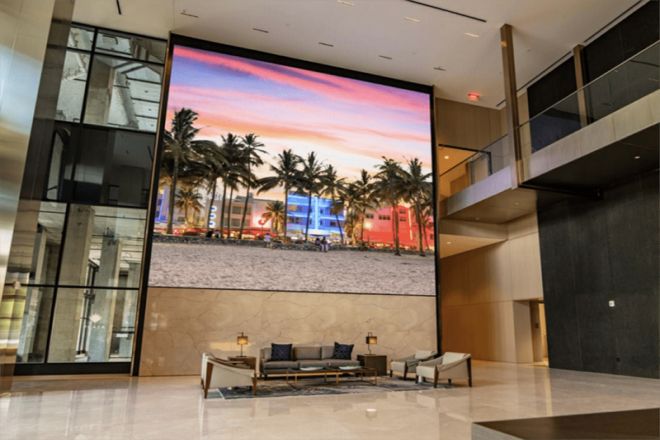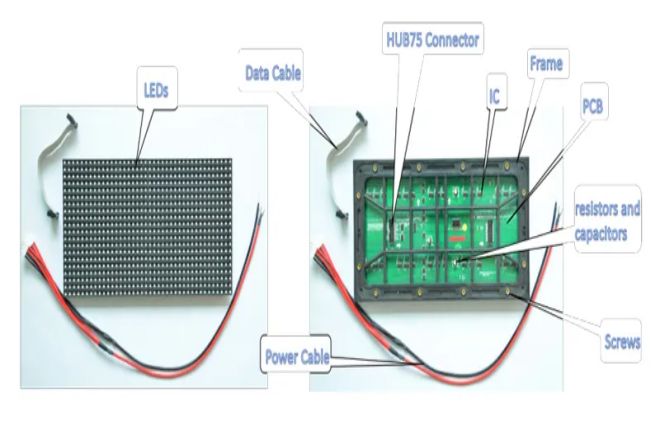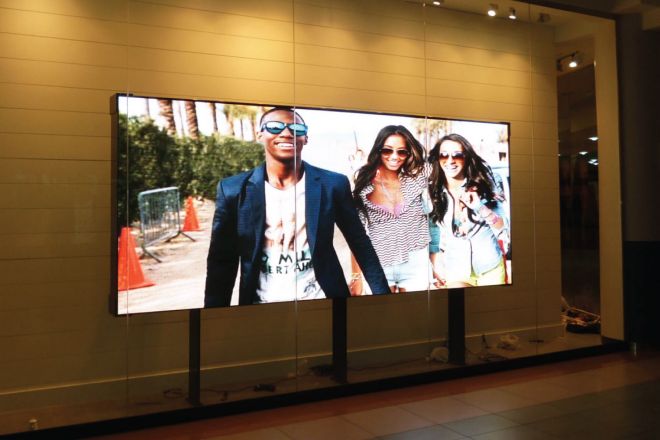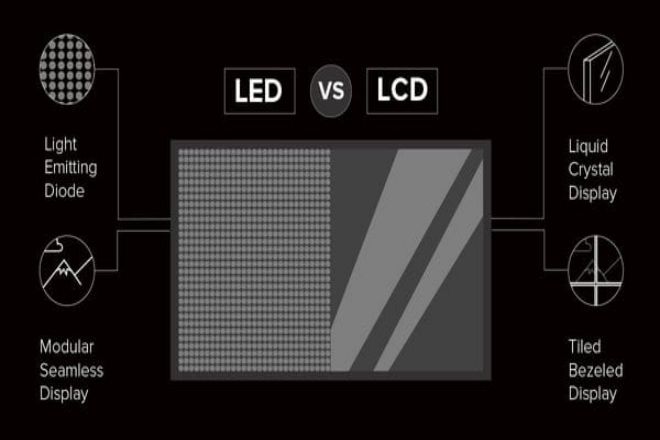序章

科学技術の急速な発展により、 LED表示画面現代の情報表示の重要な媒体として、LED ディスプレイはさまざまな分野で広く使用されています。LED ディスプレイ スクリーンを深く理解して応用するには、その動作原理を習得することが特に重要です。
LED ディスプレイ スクリーンの動作原理には、電子工学、光学、材料科学など、多くの分野の知識が関係しており、複雑で精巧なシステムです。
LED の基本概念、ディスプレイ画面の構成、駆動および制御メカニズムを深く理解することで、LED ディスプレイ画面のパフォーマンス特性をよりよく把握し、実際のアプリケーションでその価値を最大限に高めることができます。
1. LED ディスプレイは他のディスプレイ技術とどう違うのですか?
他のディスプレイ技術と比較すると、LED ディスプレイには明らかな違いがあります。LED ディスプレイ画面は、独特の光と魅力で人々の注目を集めます。他のディスプレイ技術にもそれぞれの特徴がありますが、LED ディスプレイの鮮明なコントラストにはやや劣るように見えることがよくあります。
- 動作原理から:
LED ディスプレイ画面は精密な導体のようなものです。電流を正確に制御することで、各 LED ランプビーズは最高の効果を発揮できます。
LCD ディスプレイは、液晶分子の配列によって一筆一筆画像の輪郭を描く、細心の注意を払った画家のようなものです。
OLED ディスプレイはフリーダンサーのようなもので、自己発光特性により、より滑らかで自然な画像を表示できます。
- 表示効果に関して:
LED ディスプレイ画面は鮮やかな色と高いコントラストを誇り、色彩豊かな油絵のように細部まで鮮明に映し出されます。LCD ディスプレイも鮮明な画像を生成しますが、比較すると色とコントラストが少し平坦になる場合があります。
OLED ディスプレイは、高いコントラストと広い視野角により、深みのある立体的な画像効果を実現します。
- エネルギー消費と寿命に関して:
LED ディスプレイは、消費電力が低く、寿命が長いという点で優れています。
これにより、省エネと環境保護のための好ましいソリューションとなり、長期使用に対する信頼性の高い保証が提供されます。LCD は発光効率の面でも継続的に改善されており、OLED ディスプレイも省エネの面で独自の機能を備えています。
- 構造と応用の観点から:
LED ディスプレイ スクリーンは、必要に応じてさまざまな形やサイズに組み合わせることができる、変更可能なパズルのようなものです。屋外の大型看板でも、スポーツ会場のディスプレイでも、簡単に対応できます。
LCD は固定された額縁のようなもので、限られた範囲内でしか画像を表示できません。一方、OLED ディスプレイは自由に曲げられるキャンバスのようなもので、ウェアラブル デバイスや曲面テレビなどの革新的なアプリケーションに無限の可能性を提供します。
2. LED ディスプレイの基本的なコンポーネントは何ですか?

LED ディスプレイ画面の基本コンポーネントには、主に次の部分が含まれます。
LED モジュールは LED ディスプレイ画面の基本ユニットであり、通常は複数の LED ランプビーズ、回路基板、電源、および制御チップで構成されています。LED ランプビーズはディスプレイ画面の最も基本的な発光ユニットであり、その品質がディスプレイ画面の表示効果を直接決定します。
制御チップは、LED ランプビーズの明るさと色を制御し、必要に応じて光を発する役割を果たします。
- 駆動回路:
駆動回路は LED ディスプレイ画面の重要な部分であり、LED ランプビーズに安定した電流と電圧を供給して正常な動作を確保する役割を担っています。駆動回路には通常、電源管理、明るさ調整、グレースケール制御、スキャン制御などの機能が含まれており、画像の正確な表示を実現します。
- 補助構造:
LED ディスプレイには通常、LED モジュールをサポートして固定するための金属またはアルミニウム合金フレームなどの補助構造が必要です。さらに、保護と安定した作業環境を提供するために、ラジエーター、ダストカバー、サンシェードなどもあります。
- データ回線とケーブル:
データ ラインとケーブルは、LED モジュール、コントロール カード、電源、およびその他の機器を接続して、データと電力の伝送を実現するために使用されます。これにより、さまざまな部品間で情報が確実に流れ、ディスプレイが適切に機能するようになります。
- ハウジングとスクリーン:
ハウジングは通常、金属またはプラスチックで作られ、LEDディスプレイの内部機器を保護し、サポートと固定設置を提供するために使用されます。画面はユーザーが直接見る部分であり、その品質は視聴体験に直接影響します。
上記の基本コンポーネントに加えて、ソフトウェアとファームウェアも LED ディスプレイ機能の重要な部分です。これらは物理的なコンポーネントではありませんが、ディスプレイ機能を実現する上で重要な役割を果たします。
3. LED ディスプレイの電力消費は他のディスプレイ技術と比べてどうですか?
他のディスプレイ技術と比較すると、LED ディスプレイの消費電力性能は一般的に優れています。消費電力量は、ディスプレイのサイズ、ピクセル密度、明るさ、使用される技術の効率など、いくつかの要因によって異なります。
一般的に言えばLED ディスプレイは、光効率が高く、消費電力が低いという特徴があります。LED (発光ダイオード) は、固体光源として、高効率変換と長寿命という特徴があります。従来の CRT (ブラウン管) ディスプレイと比較すると、LED ディスプレイは消費電力がはるかに少なくなります。LCD (液晶ディスプレイ) と比較すると、LED ディスプレイは、同じ明るさと色性能で消費電力が低くなる傾向があります。
しかしただし、消費電力の具体的なパフォーマンスは、特定のモデル、構成、および使用条件によっても影響を受けます。 LED ディスプレイのブランドやモデルによって、消費電力が異なる場合があります。 また、高輝度、高解像度、または特殊な表示モードを使用する場合、消費電力がそれに応じて増加する可能性があります。
LED ディスプレイの消費電力を削減するためには、さまざまな技術や方法を使用できます。たとえば、リフレッシュ周波数を最適化したり、低電力ディスプレイ モードを使用したり、ディスプレイ コンテンツとレイアウトを合理的に設計したりすることで、ある程度の消費電力を削減できます。
さらに、高効率の LED ランプビーズと駆動回路を選択し、合理的な放熱設計を採用することで、消費電力を削減し、ディスプレイの寿命を延ばすこともできます。
消費電力は、ディスプレイ技術の品質を評価する一側面にすぎないことに注意してください。ディスプレイ効果、コスト、信頼性などの他の要素も総合的に考慮する必要があります。したがって、ディスプレイ技術を選択するときは、特定のアプリケーションシナリオとニーズに基づいてトレードオフと選択を行う必要があります。
4. LED ディスプレイに画像や動画はどのように表示されますか?

LED ディスプレイ上の画像およびビデオの表示プロセスは、複数の主要なリンクとコンポーネントの共同作業を伴う複雑で繊細な技術プロセスです。
初め画像とビデオのデータは、データ ラインを通じて LED ディスプレイ制御システムに送信されます。この制御システムは通常、メイン制御ボードまたは制御カードで構成され、コンピューターやその他のビデオ ソースから信号を受信し、これらの信号をデコードして処理します。
次処理された画像とビデオのデータは、LEDランプビーズを発光させるための制御命令に変換され、これらの命令はドライバ回路を通じて各LEDモジュールに送信されます。
駆動回路は LED ディスプレイ画面の重要な部分であり、制御信号を適切な電流と電圧に変換して LED ランプビーズを駆動して光を発する役割を果たします。
駆動回路からの指示を受信すると、各 LED ランプビーズは指示の明るさと色の要件に従って発光します。
カラー LED ディスプレイの場合、各ピクセルは通常、赤、緑、青の 3 つの LED ビーズで構成されています。これら 3 つのランプ ビーズの明るさと色を正確に制御することで、豊かな色を混ぜることができます。
数万個の LED ランプビーズが同時に発光し、LED ディスプレイ上に画像や動画を形成します。
各ピクセルを個別に制御できるため、画像の詳細と色を正確に表示し、高解像度でリアルな視覚効果を実現できます。
加えて表示効果を向上させ、エネルギー消費を削減するために、LED ディスプレイでもさまざまな技術が使用されています。
たとえば、グレースケール制御技術は、LED ランプビーズの輝度レベルを調整して、よりスムーズな輝度遷移を実現します。また、スキャン制御技術は、LED ランプビーズのスキャン方法を最適化し、表示速度と安定性を向上させます。
5. LCD やプラズマなどの従来のディスプレイ技術と比較した LED ディスプレイの利点は何ですか?

LED ディスプレイには、LCD やプラズマなどの従来のディスプレイ技術に比べて、いくつかの大きな利点があります。
初めに消費電力の観点から見ると、LEDディスプレイは一般的に消費電力が低くなります。固体光源として、LED(発光ダイオード)は高効率変換の特性を持ち、同じ明るさでより少ない電力を消費できます。
比較すると、LCD(液晶ディスプレイ)やプラズマディスプレイは消費電力が高くなる場合があります。そのため、LEDディスプレイは、長期運用や大規模なアプリケーションにおいて、エネルギーコストを大幅に節約できます。
第二にLED ディスプレイは明るさとコントラストに優れています。LED ディスプレイはより高い明るさとより鮮明なコントラストを提供できるため、画像やビデオがより鮮明で鮮やかになります。
LED ディスプレイは、屋内でも屋外でも、光に邪魔されることなく優れた視覚効果を維持できます。
加えてLED ディスプレイは寿命が長く、信頼性も高くなっています。LED ランプビーズは一般的に寿命が長く、長期間の使用や高強度の作業条件に耐えることができます。
同時に、LED ディスプレイの構造設計もより頑丈で耐久性があり、さまざまな複雑な環境や設置条件に適応できます。
色彩性能の面でも、LED ディスプレイは優れた性能を発揮します。より広い色域とより正確な色彩再現を実現し、ユーザーにさらにリアルで鮮明な視覚体験をもたらします。
広告ディスプレイ、商業プロモーション、またはその他のアプリケーション シナリオに使用する場合でも、LED ディスプレイは高品質の画像やビデオに対するユーザーのニーズを満たすことができます。
ついにLED ディスプレイは環境保護の面でも利点があります。
LED ディスプレイ スクリーンは消費電力が低く寿命が長いため、使用中のエネルギー消費と二酸化炭素排出量を削減でき、現代社会のグリーン環境保護の概念と一致しています。
結論
要約すると、LED ディスプレイの動作原理を深く理解し、応用することが、その技術進歩と市場開発を促進する鍵となります。将来、科学技術の継続的な革新と応用分野の継続的な拡大により、LED ディスプレイはより多くの分野で重要な役割を果たすことになります。
最後に、LEDディスプレイについてもっと知りたい方は、 ご連絡ください。
